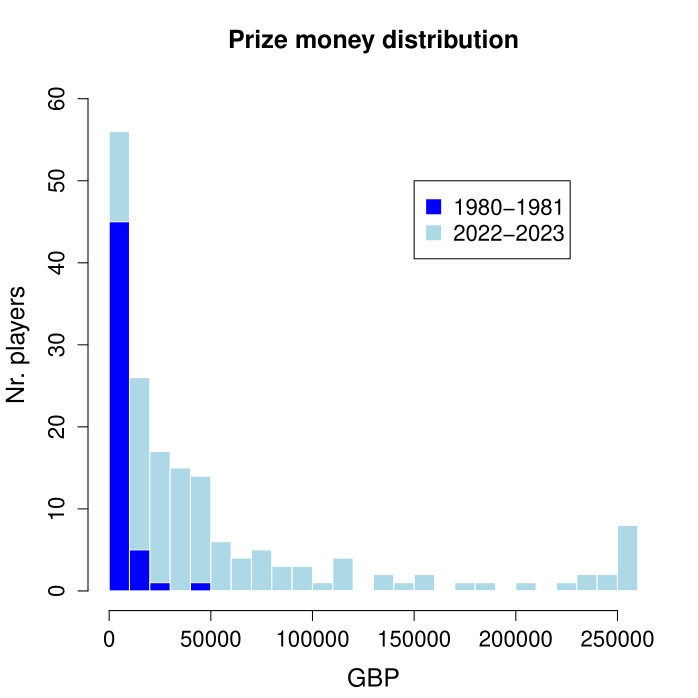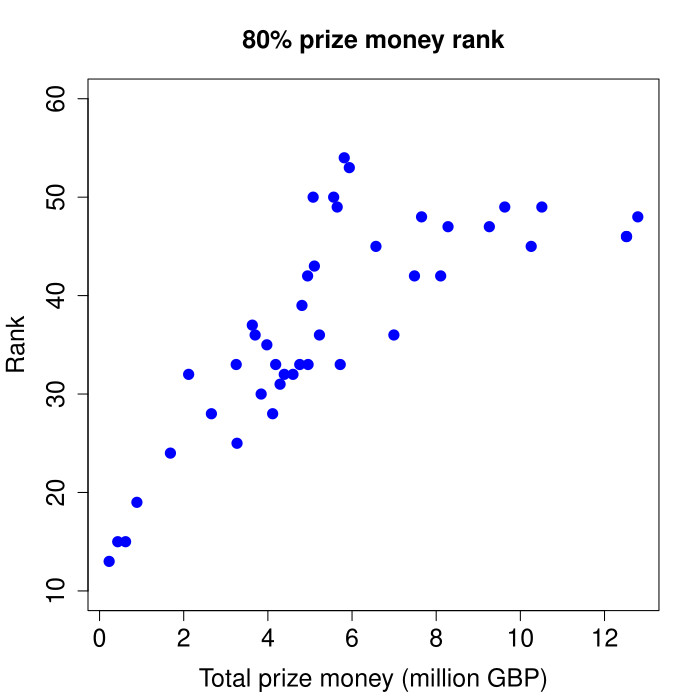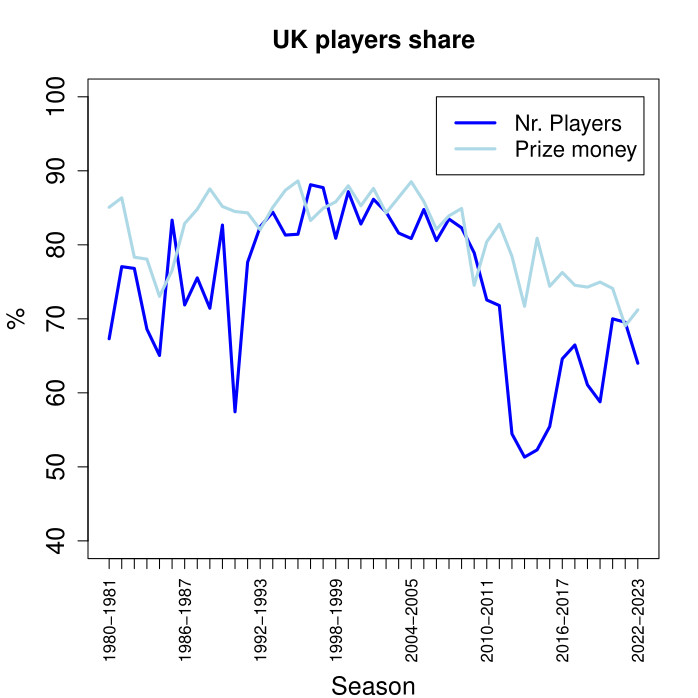Discussion of the prize money split in snooker often boils down to expressing so many opinions, with only one (and often arbitrary) statistic added for good measure.
In this article a more structural and objective analysis of the relevant data, by Wim Hordijk
It seems there is endless discussion about the distribution of prize money in snooker. And these discussions often boil down to expressing multiple opinions, with only one (and often arbitrary) statistic added for good measure. However, a more structural and objective analysis of the relevant data appears to be lacking.
So I decided to take a look at this data myself, and do some statistical analysis. Of particular interest to me are: (1) the extent to which the prize money rankings are dominated by the top players, and (2) the extent to which they are dominated by players from the United Kingdom (UK; namely England, Scotland, Wales and Northern Ireland). These two questions arise (again) in relation to the recent match-fixing scandal.
With prize money rankings for over four decades as a data set (obtained via Cue Tracker), starting with the 1980-1981 season and ending with the 2022-2023 season, I made some charts and did some statistical analysis. In this article I will highlight two of the most important results and conclusions. The full analysis, including all data and results, is available at Preprints.org.
Let’s start with the division of the prize money itself. The graph below (called a “histogram”) compares these distributions for the first (80/81; dark blue) and last (22/23; light blue) seasons in the data series. For example, this histogram shows that during the 80/81 season, there were 45 players who earned sums between 0 and 10,000 (first dark blue bar on far left), 5 players who earned sums between 10,000 and 20,000 (dark blue bar sums second from left) , etc. The last light blue bar on the far right represents the 8 players who earned over 250,000 during the 22/23 season. (All amounts are in Great Britain pounds, or GBP.)
This histogram confirms what we already know: the distribution of prize money is extremely “skewed”, with a small number of players each earning enormous amounts, and a large number of players earning very little. Obviously, this is not uncommon in professional sports. But during the 22/23 season about half of the players were earning less than 20,000, and about a third even less than 10,000. (These are real money prizes earned, apart from the $20,000 minimum income guarantee introduced last season.)
However, prize money has clearly (and drastically) increased over the last four decades. In the 80/81 season, a snooker player earned an average of 5,000, while in the 22/23 season it was 50,000. But with such a skewed distribution, the simple average sadly says relatively little, especially considering that three-quarters of players earn less than that average (and many of them slightly less).
A more meaningful measure is the degree to which the prize money ranking is dominated by the top players. This can be expressed, for example, by what I call an “80% prize money rating”. To calculate this, the prize money earned by each ranked player is first converted to a percentage of the total prize money amount (of all players combined). These percentages are then added to a subtotal, starting with player ranked 1, then ranked 2, and so on. Therefore, this subtotal amounts to 100 when the last player percentage in the ranking is also added up. “80% prize money rating” is a rating where this subtotal is 80% or more for the first time. The table below provides a simple (hypothetical) example with 10 players, where an “80% prize money rating” is 4 (shown in blue). In other words, the top 4 players collectively get over 80% of the total prize money.
The following chart shows the results for the snooker rankings. The horizontal axis shows the total prize money, and the vertical axis shows “80% prize money rating”. Each blue circle represents one of the 43 seasons in the data series. The “80% prize money rating” ranges from over 10 to over 50, but is in an upward trend as the total prize money amount increases. In other words, as the total prize money amount increases, the “80% prize money rating” generally does too. And this means that rating less dominated by the top players, as it would take more of them to collectively earn 80% of the total prize pool.
The larger total prize money is of course beneficial for everyone, but relatively more advantageous for lower ranked players. this conclusion previously withdrawn, but through a more complicated mathematical analysis. The current (and simpler) analysis confirms this earlier conclusion, and is also based on a more complete data set.
Finally, the graph below shows to what extent the ranking is dominated by players from England. The dark blue line represents the percentage of players in the rankings who are from England. This percentage varies between 50% and 90%. The light blue line represents the percentage of total prize money earned by players from the UK. This percentage varies between 70% and 90%.
What is striking is that the light blue line is almost always above the dark blue line (with a few exceptions). In other words, the percentage of prize money earned by UK players is generally greater than that of the players themselves. On average over the 43 seasons in the data set, the percentage of players from England was 74%, and their percentage of prize money earned was 81%. Standard statistical tests (called a t test), indicating that this mean difference is highly significant. It can therefore be concluded that players from the UK have historically captured a larger share of prize money than could reasonably be expected based on the percentage of players.
I will leave it to the readers themselves to state the reasons, draw further conclusions, and base opinions on them. Hopefully the results of this analysis can serve as an objective basis for this, as well as for further discussion on the distribution of prize money in snooker!
William Hordijk is an independent and interdisciplinary scientist, originally from Rotterdam, and currently living in Vienna. He has been a snooker fan since he first received BBC via cable in the Netherlands in the second half of the 1980s.

“Falls down a lot. General tv buff. Incurable zombie fan. Subtly charming problem solver. Amateur explorer.”










